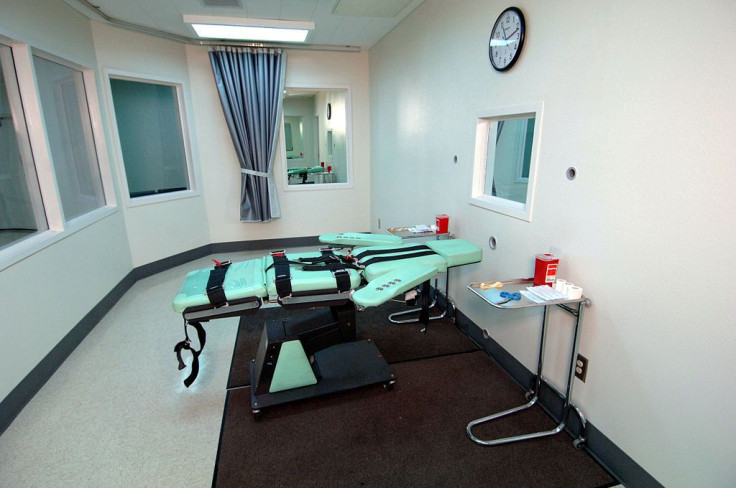The Science Of Lethal Injection: How Most Capital Punishments Work

You’re escorted into the small, windowless room that contains only a pale-turquoise gurney and two metal tables up against the wall. One table is neatly set with a pair of scissors, a small red bin, and strips of gauze. The stark cleanliness of the room is oddly disturbing and gives off a feeling of faux-comfort. A clock directly above the gurney hangs in the center of the white wall, its ticking an ominous premonition.
The next thing you notice is the large, cold mirror on the other wall facing the gurney. As you lie down on the gurney, you find yourself staring at this mirror, which is really a one-way mirror. Behind it sit the witnesses of the execution — some of your relatives, possibly several of the relatives of your victims. They’re able to watch you through that window, but you can only see the reflection of yourself lying there, like a specimen.
The prison officials strap you into the gurney and swab your arms with alcohol, then insert two IVs into each arm (one is the main line of execution; the other is a backup, just in case the first line fails). You see yourself in the mirror, lying helpless and strapped to the gurney — this is it. You’re about to be “put down." They then start the saline drops, to make sure the IVs aren’t blocked throughout the process. You’re attached to a heart monitor so the prison officials will know when you’re dead.
Anesthesia
The intravenous injection will involve a set sequence and several different drugs, given to you step-by-step. First, some form of anesthesia begins to get pumped into your veins — usually sodium thiopental or pentobarbital, meant to reduce pain and significantly decrease your breathing. This drug is technically not an analgesic or something that numbs pain nerves, but rather is meant to put you into unconsciousness that would, theoretically, prevent you from feeling pain. Within seconds, you begin to feel tired and heavy and you begin to doze off — into sleep or unconsciousness, you’re not sure.
Paralysis
Once you’re unconscious, the pancuronium bromide, or paralytic agent, begins to enter the IV — inducing paralysis of your muscles and lungs, which stops your breathing. Pancuronium bromide is a neuromuscular blocker that stops a nerve messenger, acetylcholine, from reaching the muscles. This ultimately causes muscular paralysis and respiratory arrest, which could lead to death by asphyxiation if the third drug isn’t administered.
Cardiac Arrest
And then, with potassium chloride, a salt substance, they stop your heart. This surge of chemicals impairs the heart by messing up its electrical signaling, ultimately inducing cardiac arrest, or complete stopping of the heart. The total amount of time it should take for you to die shouldn’t be more than 10 minutes.
Lethal injection is used primarily in situations of capital punishment, when a prison inmate is sentenced to death. It began as an attempt by governments to make the death penalty slightly more “humane.” The method was first proposed in 1888 by a New York doctor who claimed it would be cheaper than hanging, but it didn't yet became implemented in the states. Some 50 years later, the method was used in Nazi Germany as euthanasia before being re-introduced in America in 1977. In that year, Jay Chapman, Oklahoma’s state medical examiner, proposed this “less painful” execution method: “An intravenous saline drip shall be started in the prisoner’s arm, into which shall be introduced a lethal injection consisting of an ultra-short-acting barbiturate in combination with a chemical paralytic.”
The law allowing lethal injection was passed in Oklahoma and is currently used by 35 states (though each state uses a different drug protocol). Traditionally, most states used the three-drug combination for lethal injections, involving an anesthetic, a paralytic agent, and potassium chloride. But ever since there has been a lethal drug shortage due to the EU ban, many states have had to adopt different methods, including “one drug,” “pentobarbital,” and “propofol.”
Indeed, getting a lethal injection is by far better than electrocution, hanging, or decapitation, like used in the old days. But research has shown that lethal injection isn’t devoid of pain. For example, a 2005 study found that four out of 10 prisoners might receive inadequate anesthesia, making the process far more painful than previously believed.
It seems smooth enough and should only take a few minutes, but recently several botched executions have taken place in the U.S., where it took up to two hours for some inmates to die. Their deaths were drawn out and often painful, involving burning sensations, convulsions, and gasping for breath. This is why some states have begun to debate whether lethal injection is truly “humane” (assisted in part by the 2011 European Union export ban on lethal drugs to the U.S., due to the fact that the EU calls for “universal abolition” of the death penalty). Other researchers have argued that not enough data or research exists on the current three-drug protocol (anesthesia, pancuronium bromide, and potassium chloride) for it to be entirely safe. But it will be quite some time before the U.S. will decide whether to follow in Europe's footsteps and abolish lethal injection, or even the death penalty completely.



























